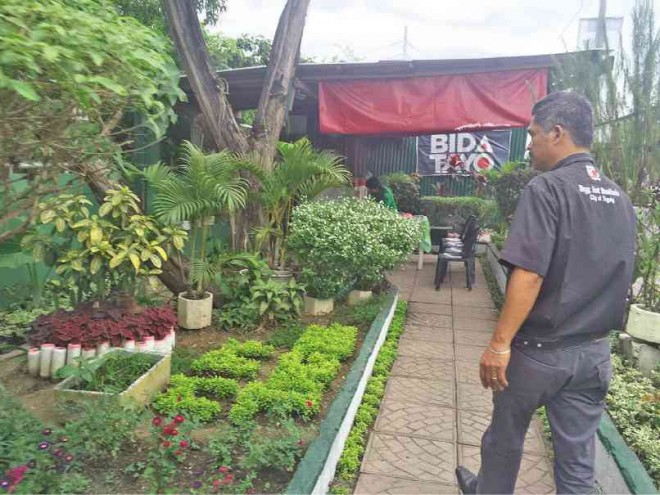
WORKERS process biodegradable waste to make organic fertilizer while at right, Fort Bonifacio barangay captain Alan Oliman shows off the herbal and medicinal plants at the MRF garden.
IT TAKES a village to turn a 300-square-meter roadside eyesore into a million-peso winning initiative as shown by some residents in Taguig City.
Barangay Fort Bonifacio used to be the reluctant host of an open dump where even garbage trucks from other cities unloaded trash in a vacant public lot.
Today, thanks to a project that began in 2011, the very same site on Pasong Tamo Extension has been transformed into a garden where mostly medicinal plants are grown and organic fertilizer is made. There is also a little shop that sells items which include bags, lampshades and drapes—all made from recycled materials.
The project, and its ripple effect across the village of 18,000 residents, earned praise for the barangay (village) as it was recently adjudged one of the cleanest in the National Capital Region (NCR) in a competition sponsored by the Metropolitan Manila Development Authority (MMDA).
Along with Barangay Holy Spirit and Blue Ridge B in Quezon City, and Barangay New Zaniga in Mandaluyong City, Barangay Fort Bonifacio was awarded a P1-million prize by the MMDA. The 2014 competition evaluated the 1,706 barangays making up the NCR with the winners announced on March 12.
Barangay Fort Bonifacio chair Alan Oliman proudly attributed their achievement to the setup of a materials recovery facility (MRF) on the dump four years ago.
From as many as four dump trucks a day, only one truck is now needed to haul the remaining 10 percent—the residual waste—out of the barangay, Oliman said.
The MRF is manned in shifts by seven community organizers who also help sell the fertilizer. The earnings are added to the project’s fund and partly serve as an incentive for the garbage collectors.
The project was launched in 2011 by then barangay chair and now Taguig Rep. Lino Cayetano in partnership with Mother Earth Foundation which conducted training and an information drive on solid waste management.
“After six months, we were doing it on our own and Mother Earth representatives just visit us from time to time to check on our progress,” Oliman recalled. Other Metro Manila residents and local officials who want to replicate their efforts can go to their barangay to ask for help, he added.
As for the P1-million prize money, Oliman said the barangay may use it to expand the land area for the MRF and purchase a plastic or paper shredder and a cement mixer, among other equipment, which could be used to produce pathway bricks out of recyclables.